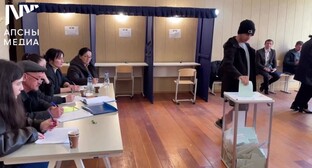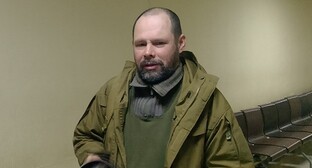06 May 2003, 02:25
Zheleznovodsk
Town in Stavropol kray (region), kray subordination, 191 km south-east of Stavropol, balneal and muddy health resort of All-Russian significance in the group of health resorts of the Caucasian Mineral Waters. Located in the south of the Stavropol Upland, at the height of 600-650 m, on southern slopes of Mount Zheleznaya.
The climate is moderately continental. Winter is mild; the temperature in January averages to -4?С. Snow cover is unstable; thaws are frequent. Spring is cooler than autumn, weather being unstable; frosts may take place until mid-April. Summer is warm; the temperature in July averages to 21?С. Hot and dry weather is frequent, though easily durable due to fresh winds and abundance of the green. Autumn is lasting and warm. Frosts, fogs and clouds appear in mid-October. Precipitations of about 600 mm a year (reaching their maximum in June).
Zheleznovodsk is 5 km of the railway station of Beshtau in the Mineralny Vody - Kislovodsk line, 12 km north of Pyatigorsk. Population (1992 est.) 29.4 thousand, (1926 est.) 20 thousand, (1979 est.) 17.8 thousand.
Discovery and first description of mineral springs of Zheleznovodsk were made by the Moscow doctor F.P. Gaaz (in 1810). First patients arrived here in 1812 and lived in tents near spring No. 1. In 1819, a state house for guests and one swimming bath near the spring were built. In 1823, mineral waters of Zheleznovodsk were explored by the medical scientist A.P. Nelyubin, who discovered a number of new springs. In 1842, 40 families of soldiers and Cossacks from the Kislovodsk fortress and sloboda (settlement) were transferred to Mount Zheleznaya, which laid foundations of Zheleznovodskaya sloboda. In 1856, a number of Zheleznovodsk springs were described by the scientist F.A. Batalin. Since 1865, the health resort used the mineral spring of Gryaznushka, given the name of Smirnovskaya after the doctor S.А. Smirnov, who was the director of the Caucasian Mineral Water Health Resort Management for a long time and made a great contribution into development of this group of health resorts. In 1898, the health resort was connected to the station of Beshtau by a railway branch. Since 1917, mineral waters of Slavyansky and Vladimirsky springs began to be used. In 1917, the resort settlement of Zheleznovodsk (having the status of a stanitsa (Cossack village) in the 19th and early 20th centuries) was given the rights of a town. In 1924, the clinic of Pyatigorsk Balneal Institute (the present Pyatigorsk Research Institute of Balneology and Physiotherapy) was organised. The health resort was heavily damaged by Nazi occupation (from August 10, 1942 to January 12, 1943) during the Great Patriotic War of 1941-1945. However, the health resort was restored in a short period of time and continued its intensive development after the war.
M.Y. Lermontov visited Zheleznovodsk during his stay in the Caucasus (1840-1841). The town was also visited by A.S. Pushkin, М.I. Glinka, А.I. Odoyevsky, L.N. Tolstoy, М.А. Balakirev, N.V. Shelgunov, V.F. Komissarzhevskaya, etc.
In 1991, the health resort of Zheleznovodsk provided sanatorium treatment for more than 100 thousand patients, operated 16 sanatoriums (about 5.4 thousand beds), including 7 trade-union ones (about 3.3 thousand beds), 3 children's ones, 2 trade-union ones for parents with children; 2 boarding houses, a resort polyclinic, a diagnostic centre shared by all the resorts; 3 bath buildings, a therapeutic mud bath. The resort also provided out-patient treatment and board and treatment authorisation (i.e. accommodation with boarding houses, hotels and flats of local inhabitants).
Mineral waters of the majority of 24 Zheleznovodsk springs are calcium-sodium carbonic sulphate-hydrocarbonate, differing from each other primarily in temperature, ranging from cold ones (below 20?C) to high-temperature ones (over 42?C). Waters of some springs, including Gaazovsky No. 1 (Lermontovsky) and Slavyanovsky are radon, waters of holes No. 56, 61 and 63 are sodium hydrocarbonate-chloride. Water of the Batalinsky spring (on the outskirts of the settlement of Inozemtsevo, near Zheleznovodsk) is sodium-magnesium sulphate (temperature up to 11?С). High-temperature and thermal waters are used for peroral treatment, baths, inhalations, lavages and other balneal procedures. Besides, waters of the Smirnovsky and the Slavyanovsky springs are bottled as healing table ones under the names of Smirnovskaya and Slavyanovskaya. Salt-alkaline waters are also used for peroral treatment and baths. Due to high contents of magnesium salts, the water of Batalinsky spring is used for peroral treatment as a purgative and bottled under the name of Batalinskaya.
Alongside with mineral waters, the health resort of Zheleznovodsk uses sulphide silt muds of Tambukan Lake (6.5 km south-east of Pyatigorsk) mostly for fangotherapy as applications, as well as in combination with electrotreatment (the so-called electrofangotherapy). Zheleznovodsk provides climatotherapeutic procedures all the year round (mostly as aerogeliotherapy in May - September ). Treatment of patients with diseases of the stomach and the intestine, the pancreas, the liver and the bile tract, as well as kidneys and the urine tract.
Located on several natural terraces, half-circling the bottom and the slopes of Mount Zheleznaya in the east, south and west. The lower terrace is mostly built-up with residential quarters and office buildings, while the upper one with constructions of the resort area. First stony constructions appeared here in the middle of the 19th century (Starobaryatinskiye baths, 1856). In the second half of the 19th and the beginning of the 20th centuries, the resort area was built up mainly in the spirit of eclecticism: Slavyanovskiye (earlier referred to as Novobaryatinskiye) baths (1875), Ostrovskiye baths (1893, architect P.Y. Syuzor) and the emir of Bukhara's summer residence (1907, architect V.N. Semyonov, the present building of the Udarnik sanatorium) in the Moresque style. In the eastern part of the resort area, there is a park (laid out in 1825; mainly poplar, beech, ash, chestnut, alder, plane, elm, etc.) with the Pushkin gallery of pre-engineered metal (purchased in 1896 at the Nizhny Novgorod fair, mounted and open in Zheleznovodsk in 1902, the present Concert Hall; similar to the Lermontov gallery in Pyatigorsk) and a cascade staircase, connecting the upper and the lower terraces of the park and decorated with fountains and pools (1932-1937). The area of the park is the starting point of the highway to the top of Mount Zheleznaya, which commands a fine panorama of Zheleznovodsk environs of opens. Sanatorium and resort buildings were built in Zheleznovodsk at the large scale from the late 1920s: the northern building of the Udarnik sanatorium (1927-1929, architect I.A. Fomin), the Dubovaya Roshcha sanatorium (1968, architect K.F. Butuzova, V.A. Zaritsky), a therapeutic mud bath (1971, architect A.I. Nikiforov), etc. New sanatorium complexes are being designed on the western slopes of Mount Razvalka and on the eastern slopes of Mount Beshtau.





Комментирование через Кавказский узел